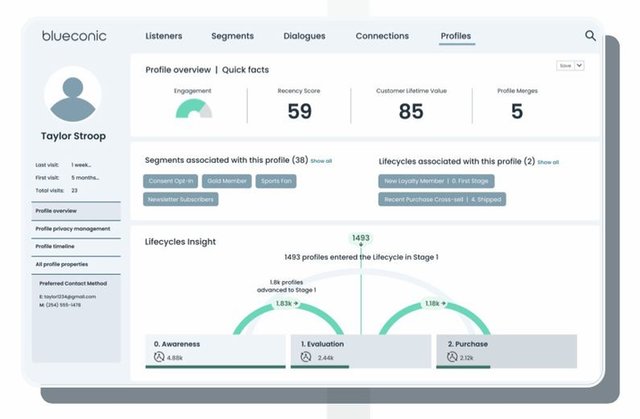

Revolutionizing Customer Insights: How BlueConic Empowers Retailers
In Conversation with Jeff Hyde, Account Director, BlueConic

How has the shift towards privacy-first data affected traditional customer data collection methods in retail, and what solutions does BlueConic offer to address these changes?
Consumer demand for privacy has necessitated a move away from third-party cookies and other intrusive tracking methods towards more transparent, consent-based approaches, such as first-party data collection. First-party data is a more valuable, accurate, and actionable source of information than third-party data because it originates directly from interactions with customers.
As a platform for centralizing and managing first-party customer data, a CDP like Blueconic enables retailers to collect consumer data with explicit consent, securely store that data, and use it for personalization, lifecycle orchestration, modeling and analytics, and more – all while adhering to individuals’ privacy preferences. As third-party cookies become obsolete and consumer data privacy laws continue to evolve, retailers that capture, create, and cultivate their first-party data muscle and approach will be better served to market to and grow their customer base in the coming years.
As a company, we’ve put considerable focus on the platform’s usability, ensuring non-technical business users are empowered to do their work in both compliant and consumer-centric ways. Marketing and other growth teams can easily use the platform’s end-to-end consent management capabilities to request and capture consent based on their objectives (e.g., collect email addresses to personalize communications, track browsing behaviors to optimize website experience, etc.). This data is stored in individual-level profiles that update in real time as consent preferences change and is automatically synchronized with all the data sources, channels, and delivery platforms in a retailer’s technology ecosystem. Additionally, BlueConic can be easily integrated with other consent providers and consent management platforms like TrustArc and OneTrust. Anchoring these consent and data protection principles into the platform’s core infrastructure and workflows ensures business teams always have access to unified, privacy-compliant first-party data they need to deliver personalized experiences while fostering consumer trust at the same time.
With the increasing importance of first-party data, how does BlueConic ensure that the data collected is not only compliant with privacy laws but also actionable for retail businesses?
Can you describe the role of BlueConic's customer data platform in helping retailers handle and overcome market disruptions more effectively?
What are some of the common challenges your customers face when unifying cross-channel data, and how does BlueConic simplify this process?
Market conditions and consumer behaviors can change rapidly. BlueConic’s user-friendly interface and automation enable marketers to easily access and activate on real-time sources and segments of customer data, so retailers can quickly adapt to market conditions like increased website traffic, new product launches, macroeconomic factors, and more. In fact, some of our customers were able to make sweeping changes to their entire web experience and email campaigns in a matter of days in reaction to the coronavirus – largely because they have BlueConic at the center of their martech stack.
Most retailers are awash in first-party data collected from online and offline sources, but it’s scattered across siloed systems that each have their own unique way of storing data and recognizing customers. Collecting, consolidating, and normalizing this data for a comprehensive customer view is not only time-consuming and resource-intensive, but also leaves marketing and other business teams at the mercy of IT to dictate what, when, where, and how they can use data to engage with customers.
BlueConic streamlines this process by unifying first-party data from disparate systems into comprehensive, individual-level profiles. These profiles update in milliseconds – capturing each individual’s most recent behaviors, transactions, scores, marketing consent preferences, and more. Equally as important, BlueConic makes this unified profile data accessible to cross-functional teams and their tools in a format they can use when and where they need it.
For instance, retailers can use what they know about their customers and prospects to improve the effectiveness of the evergreen and time-boxed programs they already run today, including seasonal offers, holiday campaigns, loyalty programs, and more. They can also use that data to power larger strategic initiatives that transform the core of their relationships with customers, such as customer lifecycle marketing programs, digital products and experience offerings, and more.
Liberate your data
BlueConic puts unified, privacy-compliant first-party data into the hands of business teams that want to transform the customer relationship and unleash growth.
Unified Customer Profiles
Build a single customer view for business teams
Multi-Dimensional Segmentation
Use real-time data to build complex segments
Lifecycle Orchestration
Orchestrate bespoke customer experiences in every lifecycle stage
Modeling & Analytics
Power customer analytics & insights with AI
Platform Capabilities:

How does BlueConic's platform enhance the ability of retail companies to gain new customer insights without needing extensive technical resources?
Built for and used by marketers, BlueConic offers an unlimited number of easily configurable dashboards that bring all different types of data and insights together within a point-and-click UI. By design, the UI eliminates the need for SQL or coding to build and activate segments, connections, reports, and more. For instance, prior to implementing our platform, an outdoor apparel retailer was unable to identify which products that men and women were buying. As a result, they couldn’t use product-based gender data for segmentation, or identify and send the proper affinity message to the right audience.
By capturing product gender data and other individual-level customer attributes in BlueConic profiles, the retailer is now able to easily create gender-based email segments and automatically send them to SFMC for activation. Using the machine learning capabilities in BlueConic’s AI Workbench, the company is also able to identify user-specific product affinity and use that insight to deliver more relevant and personalized product recommendations.
What’s more, with all their customer data in one place, the retailer is able to create and share a BlueConic Dashboard each month that highlights critical business KPIs, such as the number of new profiles with a purchase, the number of profiles with a repeat purchase, how many profiles purchased a woman’s product, and more.
BlueConic enables marketers to move beyond channel-specific campaign flows and instead, use what they know about each individual to consistently deliver the right messages (and suppress the wrong ones) at the right time, across all touchpoints and in every customer lifecycle stage.
For example, goba Sports Group uses BlueConic to acquire new customers by enhancing ad relevance and optimizing its ad spend. Leveraging the platform’s dynamic segmentation capabilities, they are able to create micro-segments of people based on interests and behaviors and automatically send those segments to Google and Facebook, where they can then target people with the most relevant messaging and offers. They can also suppress non-relevant messages, improving the overall efficiency and effectiveness for their advertising campaigns.
Bob’s Discount Furniture is a great retention example. With BlueConic, the retailer is able to consolidate all its online and offline customer data as well as transactional data from its POS and ERP systems into unified customer profiles. Because the data is persistently stored in these profiles, the ecommerce and marketing teams can build multi-dimensional segments that support both short- and long-term lifecycle marketing strategies. For example, the retailer can now execute upsell lifecycle marketing programs that enable it to engage an individual customer across channels with personalized messaging promoting a toddler bed based on the fact this customer bought a baby crib two years earlier.
Other companies, like VP Corp, use BlueConic to drive both their acquisition and retention strategies. The retailer uses BlueConic to acquire new customers using Dialogues to power their email and SMS Welcome Series on site for brands like The North Face, Smartwool, and Vans. They also use BlueConic to power the logic and segmentation for their retention loyalty marketing communications.
Could you share a few success stories of retailers leveraging BlueConic to significantly improve their customer acquisition and retention strategies?
How do predictive analytics and machine learning models integrated into your platform transform customer interactions and business outcomes for retailers?
In what ways does BlueConic help retail brands diversify their revenue models through the use of customer data?
Limited access to internal technical teams is common in retail companies. A CDP like BlueConic empowers non-technical business users with out-of-the-box AI and machine learning capabilities to identify and target likely buyers, make real-time product recommendations, identify the next best touchpoint for consumers, and more – all without having to sit in a lengthy IT queue or outsource to expensive outside agencies.
For example, one of our retail customers uses the platform’s built-in models to calculate CLV and RFM scores without any additional analytics resources. It then uses those scores to build dynamic segments that are automatically passed to its advertising platforms for immediate activation – eliminating the time spent manually uploading lists to Google and Facebook for ad targeting.
The team is even able to build and distribute customer insights dashboards to in-store associates. Because the underlying data is already unified in BlueConic, these dashboards can be sent to associates weekly, where they can use those insights to engage high-value customers and optimize product inventory based on their preferences.
Companies like Mattel that sell through traditional retail and wholesale channels, as well as direct to consumer, are able to use BlueConic to support a wide variety of use cases and activations through multiple different sales channels and revenue models. For instance, the company leveraged the first-party data it collects and unifies in BlueConic to launch Mattel Creations, a best-in-class digital destination for toy collectors. By engaging with the kidult collectibles market in this new and pronounced way, Mattel not only succeeded in creating a direct relationship with consumers around the world that they can interact with in a one-to-one manner but also opened up new revenue sources for the company, making this one of Mattel’s fastest growing business units.

Play Video

How critical is real-time data updating in today's retail environment, and what unique capabilities does BlueConic offer in this regard?
As customer centricity becomes increasingly crucial, how does BlueConic facilitate this transformation at scale for its customers?
While data privacy concerns are indeed ticking upwards, research from McKinsey shows that 71% of consumers expect personalization from companies and 76% get frustrated when they don't get a personalized customer experience. To meet these expectations, retailers need access to real-time data.
The BlueConic customer data platform is real time, meaning that data ingestion, processing, and merging happens on the fly and that data is immediately available for use. Retailers can use these real-time insights into individual customer interests and behaviors to tailor the shopping experience to their preferences and past buying behaviors. For instance, retailers can automatically display personalized product suggestions and/or content to first-time visitors based on their browsing behavior or tailor special offers to loyal customers to incentivize repeat purchases. These types of real-time capabilities are critical for retailers to stay competitive and meet consumer expectations while driving operational efficiencies at the same time.
BlueConic’s underlying profile database architecture enables companies to scale up by continually adding new profile attributes over time from any channel or source without compromising performance or inflating costs. This capability is critical for helping businesses grow and adapt over time. Using a platform like BlueConic to effectively manage the volume, variety, and velocity of their data, retailers can derive deeper insights, expand their use cases, and personalize customer experiences more effectively. In essence, BlueConic supports the ongoing journey towards greater customer understanding and engagement so companies can unlock ever higher returns from their data.





